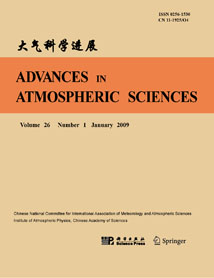| [1] |
Tianjun ZHOU, Wenxia ZHANG, Lixia ZHANG, Robin CLARK, Cheng QIAN, Qinghong ZHANG, Hui QIU, Jie JIANG, Xing ZHANG,
2022: 2021: A Year of Unprecedented Climate Extremes in Eastern Asia, North America, and Europe, ADVANCES IN ATMOSPHERIC SCIENCES, 39, 1598-1607.
doi: 10.1007/s00376-022-2063-9
|
| [2] |
Huanhuan ZHU, Zhihong JIANG, Juan LI, Wei LI, Cenxiao SUN, Laurent LI,
2020: Does CMIP6 Inspire More Confidence in Simulating Climate Extremes over China?, ADVANCES IN ATMOSPHERIC SCIENCES, 37, 1119-1132.
doi: 10.1007/s00376-020-9289-1
|
| [3] |
YAN Zhongwei, Phil D. JONES,
2008: Detecting Inhomogeneity in Daily Climate Series Using Wavelet Analysis, ADVANCES IN ATMOSPHERIC SCIENCES, 25, 157-163.
doi: 10.1007/s00376-008-0157-7
|
| [4] |
Xinyu ZHANG, Zhicong YIN, Huijun WANG, Mingkeng DUAN,
2021: Monthly Variations of Atmospheric Circulations Associated with Haze Pollution in the Yangtze River Delta and North China, ADVANCES IN ATMOSPHERIC SCIENCES, 38, 569-580.
doi: 10.1007/s00376-020-0227-z
|
| [5] |
QIAN Cheng, YAN Zhongwei, Zhaohua WU, FU Congbin, TU Kai,
2011: Trends in Temperature Extremes in Association with Weather-Intraseasonal Fluctuations in Eastern China, ADVANCES IN ATMOSPHERIC SCIENCES, 28, 297-309.
doi: 10.1007/s00376-010-9242-9
|
| [6] |
ZHOU Botao, ZHAO Ping,
2010: Influence of the Asian-Pacific Oscillation on Spring Precipitation over Central Eastern China, ADVANCES IN ATMOSPHERIC SCIENCES, 27, 575-582.
doi: 10.1007/s00376-009-9058-7
|
| [7] |
Xiaojuan ZHANG, Fei ZHENG, Jiang ZHU, Xingrong CHEN,
2022: Observed Frequent Occurrences of Marine Heatwaves in Most Ocean Regions during the Last Two Decades, ADVANCES IN ATMOSPHERIC SCIENCES, 39, 1579-1587.
doi: 10.1007/s00376-022-1291-3
|
| [8] |
Huqiang ZHANG, LI Yaohui, GAO Xuejie,
2009: Potential Impacts of Land-Use on Climate Variability and Extremes, ADVANCES IN ATMOSPHERIC SCIENCES, 26, 840-854.
doi: 10.1007/s00376-009-8047-1
|
| [9] |
Ya WANG, Gang HUANG, Baoxiang PAN, Pengfei LIN, Niklas BOERS, Weichen TAO, Yutong CHEN, BO LIU, Haijie LI,
2024: Correcting Climate Model Sea Surface Temperature Simulations with Generative Adversarial Networks: Climatology, Interannual Variability, and Extremes, ADVANCES IN ATMOSPHERIC SCIENCES.
doi: 10.1007/s00376-024-3288-6
|
| [10] |
Hengyi WENG,
2012: Impacts of Multi-Scale Solar Activity on Climate. Part II: Dominant Timescales in Decadal-Centennial Climate Variability, ADVANCES IN ATMOSPHERIC SCIENCES, 29, 887-908.
doi: 10.1007/s00376-012-1239-0
|
| [11] |
Kate M. WILLETT,
2023: HadISDH.extremes Part I: A Gridded Wet Bulb Temperature Extremes Index Product for Climate Monitoring, ADVANCES IN ATMOSPHERIC SCIENCES, 40, 1952-1967.
doi: 10.1007/s00376-023-2347-8
|
| [12] |
Wenxia ZHANG, Robin CLARK, Tianjun ZHOU, Laurent LI, Chao LI, Juan RIVERA, Lixia ZHANG, Kexin GUI, Tingyu ZHANG, Lan LI, Rongyun PAN, Yongjun CHEN, Shijie TANG, Xin HUANG, Shuai HU,
2024: 2023: Weather and Climate Extremes Hitting the Globe with Emerging Features, ADVANCES IN ATMOSPHERIC SCIENCES.
doi: 10.1007/s00376-024-4080-3
|
| [13] |
Lu Riyu,
2001: Atmospheric Circulations and Sea Surface Temperatures Related to the Convection over the Western Pacific Warm Pool on the Interannual Scale, ADVANCES IN ATMOSPHERIC SCIENCES, 18, 270-282.
doi: 10.1007/s00376-001-0019-z
|
| [14] |
Peihua QIN, Zhenghui XIE, Jing ZOU, Shuang LIU, Si CHEN,
2021: Future Precipitation Extremes in China under Climate Change and Their Physical Quantification Based on a Regional Climate Model and CMIP5 Model Simulations, ADVANCES IN ATMOSPHERIC SCIENCES, 38, 460-479.
doi: 10.1007/s00376-020-0141-4
|
| [15] |
Liu Hui, Wu Guoxiong,
1997: Impacts of Land Surface on Climate of July and Onset of Summer Monsoon: A Study with an AGCM plus SSiB, ADVANCES IN ATMOSPHERIC SCIENCES, 14, 289-308.
doi: 10.1007/s00376-997-0051-8
|
| [16] |
Hengyi WENG,
2003: Impact of the 11-yr Solar Activity on the QBO in the Climate System, ADVANCES IN ATMOSPHERIC SCIENCES, 20, 303-309.
doi: 10.1007/s00376-003-0017-4
|
| [17] |
Yun Qian, Hailong Wang, Chuanfeng Zhao, Chun Zhao, Siyu Chen, Xiao-Ming Hu, Shichang Kang,
2022: Understanding Third Pole Atmospheric Dynamics and Land Surface Processes and Their Associations with the Cryosphere, Air Quality, and Climate Change, ADVANCES IN ATMOSPHERIC SCIENCES, 39, 1017-1020.
doi: 10.1007/s00376-022-2004-7
|
| [18] |
Peihua QIN, Zhenghui XIE, Rui HAN, Buchun LIU,
2024: Evaluation and Projection of Population Exposure to Temperature Extremes over the Beijing−Tianjin−Hebei Region Using a High-Resolution Regional Climate Model RegCM4 Ensemble, ADVANCES IN ATMOSPHERIC SCIENCES.
doi: 10.1007/s00376-023-3123-5
|
| [19] |
Huang Ronghui, Wu Yifang,
1989: The Influence of ENSO on the Summer Climate Change in China and Its Mechanism, ADVANCES IN ATMOSPHERIC SCIENCES, 6, 21-32.
doi: 10.1007/BF02656915
|
| [20] |
Guo Weidong, Sun Shufen, Qian Yongfu,
2002: Case Analyses and Numerical Simulation of Soil Thermal Impacts on Land Surface Energy Budget Based on an Off-Line Land Surface Model, ADVANCES IN ATMOSPHERIC SCIENCES, 19, 500-512.
doi: 10.1007/s00376-002-0082-0
|















 AAS Website
AAS Website 
 AAS WeChat
AAS WeChat 
 DownLoad:
DownLoad: